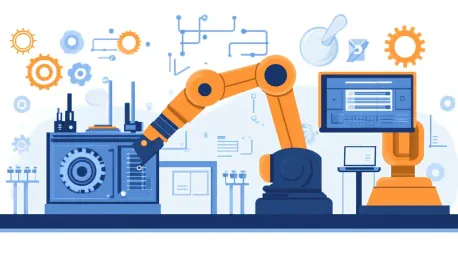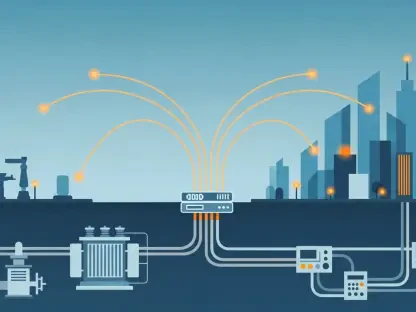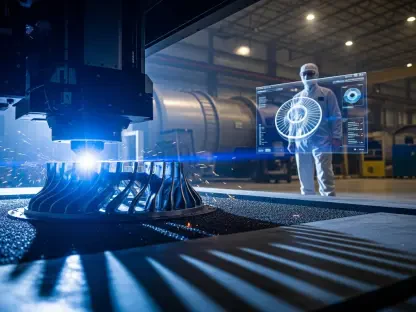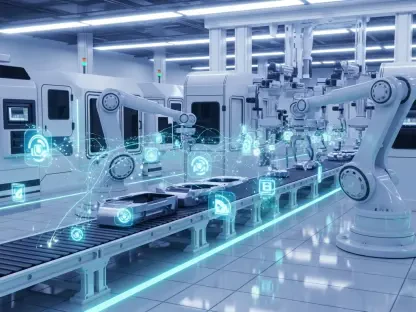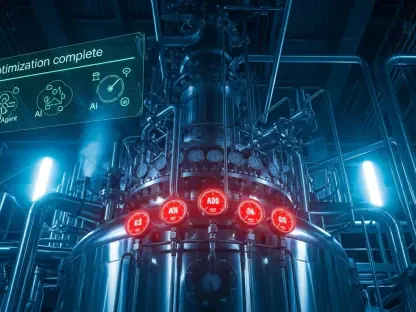In today’s rapidly evolving manufacturing landscape, emerging technologies are ushering in a new era of efficiency, productivity, and sustainability. These advancements, particularly those involving AIoT (Artificial Intelligence of Things), predictive maintenance, and machine learning, are reshaping the way factories operate and are setting the stage for the future of manufacturing. This article delves into key technological trends and innovations driving this transformation.
The Rise of AIoT in Manufacturing
Integrating AI and IoT for Enhanced Efficiency
AIoT, the fusion of Artificial Intelligence and the Internet of Things, is playing a crucial role in the digitalization of manufacturing. By integrating AI and IoT, manufacturers can leverage real-time data analytics, predictive insights, and automation capabilities to streamline processes. This technological merger not only improves operational efficiency but also significantly reduces downtime and enhances safety protocols within factories. Through AIoT, manufacturers are able to automate complex tasks that traditionally required human intervention, leading to faster production cycles and reduced human error.
Real-time data analytics supported by AI and IoT technologies enables manufacturers to make informed decisions promptly. The immediacy of data processing allows for instant responses to operational changes, thus maintaining production flow without unnecessary interruptions. This capacity for real-time monitoring is especially beneficial in identifying small issues before they become significant problems, such as machinery malfunctions or assembly line bottlenecks. As factories become increasingly interconnected, the role of AIoT in facilitating seamless and efficient operations will undeniably expand.
Real-Time Data and Predictive Insights
Manufacturing environments are increasingly relying on real-time data to make informed decisions that enhance efficiency and reliability. AIoT technologies provide manufacturers with detailed analytics that help predict equipment failures before they happen, thus preventing costly downtimes. Predictive insights also contribute to better resource allocation and lead to more efficient operation workflows. For instance, sensors embedded in machinery can collect vast amounts of operational data that, when analyzed by AI, reveal patterns and trends indicative of potential failures.
This predictive approach becomes invaluable in planning maintenance schedules and optimizing machine performance. By anticipating problems before they arise, manufacturers can proactively address them, ensuring consistent production and extending the lifespan of crucial equipment. Additionally, predictive analytics helps in optimizing supply chains by predicting demand fluctuations and adjusting inventory levels accordingly. This forward-thinking capability allows manufacturers to stay ahead of potential disruptions and maintain smooth operations, further cementing the importance of AIoT in modern manufacturing.
Advancements in Predictive Maintenance
Machine Learning and Predictive Models
The use of machine learning and AI in predictive maintenance is revolutionizing manufacturing operations. By applying sophisticated algorithms, manufacturers can predict when equipment is likely to fail, allowing them to perform maintenance proactively. This approach reduces the frequency of unplanned downtimes and extends the lifespan of machinery, leading to substantial cost savings and improved operational continuity. Predictive maintenance has proven to be a game-changer, especially for industries where machinery uptime is critical to productivity and profitability.
Machine learning models are trained on historical data collected from various sensors and monitoring systems across the factory floor. These models analyze the data to identify patterns and predict future equipment behavior. With accuracy rates often exceeding 99%, these predictive models enable manufacturers to allocate resources efficiently and plan maintenance activities without disrupting production schedules. This transformation in maintenance strategy marks a shift from reactive to proactive management, setting new standards for operational excellence in the manufacturing sector.
Impact on Operational Continuity
Predictive maintenance, facilitated by AI-driven systems, can achieve accuracy rates that ensure equipment is maintained at optimal performance levels, minimizing the risk of unexpected breakdowns. For manufacturers, this translates into a more reliable production process and reduced maintenance costs over time. By identifying potential issues early, manufacturers can schedule planned maintenance during non-peak hours, thereby maintaining continuous production and avoiding unforeseen downtimes that can be costly.
The implementation of predictive maintenance also has a positive impact on worker safety and overall operational sustainability. By foreseeing and addressing equipment failures before they occur, manufacturers can mitigate risks associated with machinery malfunctions, protecting both workers and the production environment. Furthermore, the efficiencies gained through predictive maintenance contribute to a reduction in energy consumption and waste, aligning manufacturing practices with broader environmental and sustainability goals.
Embracing Smart Building Technologies
Sustainability and Energy Efficiency
Smart building technologies are becoming increasingly important for manufacturers as they strive to adopt sustainable and energy-efficient practices. These technologies enable the integration of systems and infrastructure that optimize resource use, reduce waste, and lower energy consumption. Moving towards zero waste and minimizing carbon footprints are becoming strategic priorities for manufacturers aiming to meet stringent environmental regulations and sustainability targets.
The implementation of smart building technologies in manufacturing facilities includes a range of applications such as intelligent lighting, advanced HVAC systems, and energy monitoring solutions. These technologies not only enhance environmental performance but also lead to significant cost savings. For example, smart sensors can dynamically adjust lighting and temperature based on occupancy and usage patterns, thereby conserving energy and reducing utility costs. By leveraging these technologies, manufacturers can achieve a greener, more efficient production environment.
Bridging Sustainability Gaps
Industry experts, like Gianluca Cassanova from ABB Electrification, advocate for the use of smart building technologies to drive sustainability in manufacturing. These applications help bridge gaps in environmental accountability, ensuring that manufacturing processes are not only efficient but also eco-friendly. The integration of smart systems enables manufacturers to track and manage their environmental impact in real time, allowing for continuous improvement and adherence to sustainability standards.
This focus on sustainability is becoming a key strategic priority for manufacturers worldwide. The shift towards environmentally conscious manufacturing is driven by both regulatory pressures and consumer demand for greener products. By investing in smart building technologies, manufacturers can enhance their competitive edge, improve brand reputation, and contribute to global sustainability goals. The adoption of such practices underscores the critical role of technology in achieving a sustainable and responsible manufacturing future.
Overcoming Challenges to AI Maturity
Scaling AI Implementations
Achieving AI maturity in manufacturing involves scaling pilot projects to full-scale enterprise solutions, a transition often fraught with challenges. These challenges include supply chain dependencies, regulatory hurdles, and the inherent complexities of manufacturing operations. Manufacturers must develop resilient and adaptable AI strategies to overcome these obstacles and realize substantial productivity benefits from their AI investments.
Scaling AI implementations requires a systematic approach that includes comprehensive data management, robust infrastructure, and workforce training. Manufacturers need to ensure that their data is accurate, comprehensive, and accessible to fully leverage AI capabilities. Additionally, building a scalable infrastructure capable of supporting AI applications is crucial for seamless integration. Training the workforce to operate and maintain AI systems is equally important, as it ensures that employees are equipped with the necessary skills to navigate the digital transformation.
Addressing Regulatory and Supply Chain Hurdles
Regulatory requirements and supply chain complexities can impede the widespread adoption of AI in manufacturing. To navigate these challenges, manufacturers need to adopt strategic approaches that ensure compliance while maintaining operational efficiency. Developing AI solutions that adhere to regulatory standards requires a thorough understanding of industry-specific regulations and a commitment to continuous monitoring and adjustment.
Supply chain dependencies add another layer of complexity to AI adoption. Manufacturers must work closely with suppliers and partners to ensure that AI-enabled systems are integrated smoothly across the supply chain. This collaboration fosters a cohesive ecosystem where data can be shared and analyzed effectively. By addressing these hurdles proactively, manufacturers can fully harness the power of AI to drive innovation, improve operational efficiency, and achieve long-term growth.
Role of Industrial Robots in Manufacturing
AI-Driven Predictive Maintenance for Robots
Reliable industrial robots are essential for maintaining fail-safe manufacturing operations. AI-driven predictive maintenance models help identify potential robotic system failures before they occur, ensuring continuous operation. This preemptive approach is particularly valuable in complex manufacturing environments where robotic systems are integral to production processes. The ability to foresee and address issues before they impact production is a significant advantage in achieving operational excellence.
AI-driven predictive maintenance uses advanced algorithms to analyze data from robotic systems, detecting anomalies that indicate potential failures. By identifying these issues early, manufacturers can schedule maintenance activities without disrupting production. This ensures that robotic systems operate at peak performance, reducing the risk of costly downtime. Implementing such predictive models enhances the reliability and efficiency of manufacturing operations, making it a critical component of modern industrial strategies.
Financial Implications of Operational Disruptions
Any disruption in robotic systems can have significant financial implications for manufacturers due to the high operational costs associated with downtime and maintenance. By implementing AI-driven predictive maintenance, manufacturers can reduce the risk of such disruptions, safeguarding their investments and ensuring uninterrupted production. This proactive maintenance strategy not only mitigates potential financial losses but also optimizes resource allocation and extends the lifespan of robotic systems.
Moreover, the financial benefits of predictive maintenance extend beyond immediate cost savings. By maintaining consistent production flows, manufacturers can meet delivery deadlines, enhance customer satisfaction, and build a reputation for reliability. The long-term financial health of manufacturing operations is closely tied to the ability to prevent unexpected disruptions, making AI-driven predictive maintenance an indispensable tool for achieving sustainable growth and competitiveness.
Leveraging Thermal Imaging for Proactive Maintenance
Detecting Irregular Heat Patterns
Thermal imaging or thermography is a proactive maintenance tool that uses infrared cameras to detect irregular heat patterns in equipment. This method allows manufacturers to identify and address potential issues before they escalate into major problems, thereby enhancing machinery reliability and reducing downtime. By capturing thermal images and analyzing heat distribution, manufacturers can pinpoint areas where equipment may be overheating or underperforming, thereby facilitating timely interventions.
The application of thermal imaging in maintenance practices offers a non-invasive way to monitor the health of machinery. Infrared cameras can scan large areas quickly, providing comprehensive insights into equipment conditions. This proactive approach enables maintenance teams to focus on specific areas that require attention, optimizing the use of resources and reducing the likelihood of unexpected failures. As a result, thermal imaging becomes a vital component of a comprehensive maintenance strategy that ensures operational continuity and efficiency.
Benefits of Early Detection
Early detection of equipment anomalies through thermal imaging contributes to longer machinery lifespans and reduced maintenance costs. This preventive approach ensures that manufacturing operations run smoothly and efficiently, minimizing the likelihood of unexpected failures and production delays. By addressing issues at the earliest stages, manufacturers can avoid more extensive and costly repairs that result from neglected problems.
The benefits of early detection extend to enhancing overall operational safety. By identifying potential hazards before they materialize, thermal imaging helps create a safer working environment for employees. This technology also complements other predictive maintenance tools, providing a holistic view of equipment health and performance. The integration of thermal imaging into maintenance routines exemplifies the proactive mindset required to achieve optimal manufacturing outcomes.
Innovations through Public-Private Partnerships
Collaborative Innovation Models
Public-private partnerships are becoming a cornerstone of innovation in manufacturing. Initiatives such as Pittsburgh’s AI tech community, in collaboration with NVIDIA, Carnegie Mellon University, and the University of Pittsburgh, exemplify the potential of these collaborative models. Such partnerships foster technological advancements and accelerate innovation in the manufacturing sector. By combining resources and expertise from both public and private sectors, these partnerships drive the development of cutting-edge solutions to complex manufacturing challenges.
Collaborative innovation models facilitate the sharing of knowledge, skills, and technologies that might otherwise be siloed within individual organizations. This synergy enables faster and more effective problem-solving, leading to the creation of innovative products and processes. For example, the AI tech community in Pittsburgh is working on projects that harness AI and machine learning to optimize manufacturing workflows, improve product quality, and enhance operational efficiency. These collaborative efforts demonstrate the transformative potential of public-private partnerships in advancing the manufacturing industry.
Accelerating Technological Advancements
In today’s swiftly changing manufacturing industry, groundbreaking technologies are paving the way for unprecedented levels of efficiency, productivity, and sustainability. These innovations, particularly in the realms of the Artificial Intelligence of Things (AIoT), predictive maintenance, and machine learning, are fundamentally transforming how factories operate, preparing them for future advancements. This wave of technology is not just marginally improving manufacturing processes but revolutionizing them. AIoT helps by connecting devices and systems in intelligent ways, enabling more streamlined and coordinated operations. Predictive maintenance utilizes data analytics to foresee equipment failures before they happen, reducing downtime and saving costs. Machine learning algorithms are optimizing various manufacturing processes, making them faster and more accurate. These technologies are setting new benchmarks in the industry, offering solutions that were previously unimaginable. This article explores the most significant technological trends and innovations that are driving this remarkable transformation in modern manufacturing.
